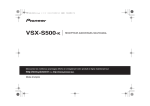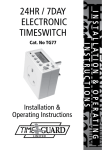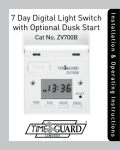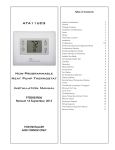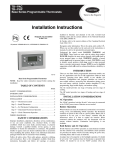Download QUANTA 230W Security Floodlight Operating instructions
Transcript
SLB500-Black/SLW500-White 150W PIR HALOGEN FLOODLIGHT SLB150-Black/SLW150-White INSTALLATION & OPERATING INSTRUCTIONS 500W PIR HALOGEN FLOODLIGHT SLB500/SLW500 500W PIR HALOGEN FLOODLIGHT WEATHERPROOF LAMP TYPE 500w IP44 MAXIMUM PIR SWITCHING 2000w MAXIMUM MANUAL ON/OFF OVERRIDE TIME ON 5sec 5min DETECTION ANGLE ADJUSTABLE 140° ADJUSTABLE DUSK TO DAWN DETECTION RANGE ADJUSTABLE 12m ADJUSTABLE 3 YEAR GUARANTEE In the unlikely event of this product becoming faulty due to defective material or manufacture, within 3 years of the date of purchase, please return it to your supplier with proof of purchase and it will be replaced free of charge. Should you encounter any difficulty please contact our helpline on 020 8450 0515. SLB150/SLW150 150W PIR HALOGEN FLOODLIGHT WEATHERPROOF LAMP TYPE 150w IP44 MAXIMUM PIR SWITCHING 2000w MAXIMUM MANUAL ON/OFF OVERRIDE TIME ON 5sec 5min DETECTION ANGLE ADJUSTABLE 140° ADJUSTABLE DUSK TO DAWN DETECTION RANGE ADJUSTABLE 12m ADJUSTABLE 3 YEAR GUARANTEE In the unlikely event of this product becoming faulty due to defective material or manufacture, within 3 years of the date of purchase, please return it to your supplier with proof of purchase and it will be replaced free of charge. Should you encounter any difficulty please contact our helpline on 020 8450 0515. SECTION ONE GENERAL INFORMATION The unit utilises passive infrared technology to detect heat radiation of moving human bodies. Upon detection, the lamp will illuminate for a user-determined time period. An integral daylight sensor ensures night-only operation. PARTS INCLUDED - Luminaire c/w PIR Sensor unit. - Instruction manual. Please keep safe for future reference. - Accessory Pack. - Tungsten halogen bulb TOOLS & PARTS NEEDED - Electric/hand-held drill & bits. - Terminal or Electricians screwdriver - Large slotted/philips screwdriver - Wire cutters Unit is for outdoor use only. Unit must be mounted on a non-flammable surface as a fixed luminaire, and is not suitable for portable use. The unit can get very hot during use. Ensure the unit has cooled before handling. Ensure adequate ventilation space is allowed between the unit and any object above, in front or to either side of the unit. Suggested space is 0.5m above, 0.3m to either side & 1.0m in front. If in any doubt, consult a qualified tradesperson or electrician. SECTION TWO SELECTING THE LOCATION The motion detector has a number of detection zones, at various vertical and horizontal angles as shown (see diagram A). A moving human body needs to cross/enter one of these zones to activate the sensor. The best all-round coverage is achieved with the unit mounted at the optimum height of 2.5m. Careful positioning of the sensor will be required to ensure optimum performance. See diagram A detailing detection range and direction. The sensor is more sensitive to movement ACROSS its field of vision than to movement directly TOWARDS (see diagram B). Therefore position the unit so that the sensor looks ACROSS the likely approach path. Avoid positioning the sensor where there are any sources of heat in the detection area (extractor fans, tumble dryer exhausts etc.). Reflective surfaces (ie pools of water or white-painted walls) and overhanging branches may cause false activation under extreme conditions. During extreme weather conditions the motion sensor may exhibit unusual behaviour. This does not indicate a fault with the sensor. Once normal weather conditions return, the sensor will resume normal operation. SECTION THREE INSTALLATION Wiring Box Cover Retaining Lugs After choosing a suitable location (see previous section) install the unit as follows: Insert small screwdriver and gently push and lift cover off. Remove the wiring box cover by gently pushing the side retaining lugs inwards and lift off. The unit is suitable for connection to a 230 V ac 50Hz electricity supply. It is suggested that 3-core round flexible cable of 1mm2 gauge is used. A isolating should be installed to switch the power to the unit ON & OFF. This allows the sensor to be easily switched off when not required or for maintenance purposes. Unfasten the screw on the top of the floodlight. Install the halogen bulb, making sure not to touch the bulb with bare hands. It is suggested that the bulb is handled using a dry cloth. Ensure the bulb is correctly fitted in the lampholder before use. Re-attach the front cover, do not overtighten the fixing screw. Mark the position of the fitting holes from the wall bracket. Drill the holes. Insert the rawl plugs into the holes. Fix the bracket to the wall. *** IMPORTANT *** Switch off the electricity at the fuse box by removing the relevant fuse or switching off the circuit breaker before proceeding with the installation. CONNECTION PIERCE & PASS THE CABLE THROUGH THE GROMMET BEFORE PROCEEDING. Connect the cable to the terminal block on the unit as follows (see connection diagram): NEUTRAL (Blue) EARTH (Green/Yellow) LIVE (Brown) N L Ensure that the connections are secure. For details of override connections, please see later sections. Secure the cable using the cord grip provided. Re-attach the wiring box cover, ensuring a weatherproof seal is obtained. Fix the floodlight to the bracket CONNECTION DIAGRAM Mains Supply Isolation Switch The diagram below also shows the required connections for the addition of slave luminaires. When adding slaves, be sure not to exceed the maximum switchable load (see Technical Specifications). SECTION FOUR OPERATION AND TESTING WALK TEST PROCEDURE The sensor will rotate from left to right, and tilt forward or backward. Adjust the sensor to point in the required direction. The unit can be set up in daylight or at night. Set the time adjustment to minimum (fully anti-clockwise). Turn the power to the unit on. The lamp will illuminate for approximately 30 seconds. This indicates the unit is wired correctly. After approximately 30 seconds the light will turn off. The unit is now in Test Mode. TEST MODE The lamp will now illuminate for approximately 5 seconds every time movement is detected. Walk across the detection area approximately 5 metres from the unit. Each time you are detected the lamp will illuminate. Now stand still until the lamp extinguishes (this should take approx. 5 seconds). Start moving again, when you are detected again, the lamp will illuminate. Repeat the above, walking at various angles and distances to the unit. This will help you to establish the detection pattern. If the detection area is too small for your requirements, try angling the sensor head up. This will increase the detection area. Angling the head downwards will reduce the detection area should a smaller coverage be required. SETTING UP FOR AUTOMATIC OPERATION When walk tests are complete, the unit can be automatically switched into Automatic Mode. If you simply cease movement within the detection area for approximately 60 seconds, the unit will then switch to Automatic Mode. The TIME setting controls how long the unit remains illuminated following activation and after all motion ceases. (See diagram C, the time adjustment knob is indicated by the "Clock" symbol). The minimum time (fully anti-clockwise) is approx. 5 seconds, whilst the maximum time (fully clockwise) is approx. 5 minutes. Set the control to the desired setting between these limits. The DUSK control determines the level of darkness required for the unit to start operating. The setting is best achieved by the procedure below: Set the DUSK control knob fully anti clockwise (See diagram C, the DUSK adjustment knob is indicated by the "Moon" and "Sun" symbols). Wait until darkness falls. When the ambient light level reaches the level of darkness at which you wish the lamp to become operative (i.e.: at dusk) SLOWLY rotate the control in a clockwise direction until a point is reached where the lamp illuminates. Leave the control set at this point. At this position the unit should become operative at approximately the same level of darkness each evening. Observe the operation of the unit. If the unit is starting to operate too early (i.e.: when it is quite light) adjust the control slightly anti-clockwise. If the unit starts to operate too late (i.e.: when it is very dark). Adjust the control slightly clockwise. Continue to adjust until the unit operates as desired. MASKING THE SENSOR LENS To restrict the sensor coverage, preventing detection in unwanted areas, mask the sensor lens using the masking label provided (see diagram D). For your information, the top section of the lens covers long range detection, the bottom covers short range. Similarly the left and right lens sections cover the left and right detection areas respectively. (see diagram E) MANUAL OVERRIDE MODE The light can be switched on for longer time periods by use of the Manual Override Mode. This can be activated at night by using the internal wall switch or circuit breaker. Switch the internal wall switch/circuit breaker twice (off/on off/on) within 2 seconds. The unit will now illuminate continuously until dawn or until switched back into Auto Mode. To switch the unit back into Auto Mode, flick the internal wall switch/circuit breaker once (off/on) within one second. The unit will return to its Auto mode and will operate as set up during the walk test period. SECTION FIVE TECHNICAL SPECIFICATIONS Detection Range Up to 12 metres Detection Angle 140º Power Supply 230 V AC ~ 50Hz Maximum Switchable Load (Including fitted lamp) 2000W (4 x 500W) Tungsten Halogen 1000W (10 x 100W GLS) Incandescent Lamp Type SLB/W150 230V Linear Tungsten Halogen 150W max (R7S cap) SLB/W500 230V Linear Tungsten Halogen 500W max (R7S cap) Time On Adjustment 5 seconds - 5 minutes Dusk Level Adjustment Day & night or night only operation Environmental Protection IP44 (suitable for outdoor use) EC Directives Conforms to 73/23/EEC, 89/336/EEC In the event of the cover glass shattering, do not replace with normal household glass. Contact the helpline for replacement details. If you experience problems refer to Troubleshooting Guide. If problems still exist, do not immediately return the unit to store. Telephone the Timeguard Customer Helpline 020 8450 0515 Qualified Customer Support Co-ordinators will be on-line to assist in resolving your query. SECTION SIX TROUBLESHOOTING GUIDE PROBLEM SOLUTION ❏ Lamp stays ON all the time at night. The unit may be suffering from false activation. Cover the sensor lens completely with a thick cloth. This will prevent the sensor from "seeing" anything. If the unit now switches off after the set time duration and does not reactivate, this indicates that the problem was caused by false activation. The problem may be solved by slightly adjusting the direction/angle of the sensor head (see previous section). You may not be allowing the unit time to complete it's warm-up period. Stand well out of the detection range and wait (the warm-up period should never exceed 5 minutes). Occasionally, winds may activate the sensor. Sometimes passages between buildings etc. can cause a "wind tunnel" effect. Ensure the unit is not positioned so as to allow detection of cars/people using public thoroughfares adjacent to your property. ❏ PIR keeps activating for no reason / at random. ❏ PIR sensor will not operate at all. Check that the power is switched ON at the circuit breaker/internal wall switch. Turn OFF the power to the unit and check the wiring connections as per the diagram (see previous section 3). Ensure no connections are loose. Check the lamp. If the lamp has failed, replace. Ensure that the lamp is seated correctly in the lampholder. ❏ The PIR sensor will not operate at night. The level of ambient light in the area may be too bright to allow operation at the current DUSK setting. During the hours of darkness, adjust the DUSK control slowly clockwise until the lamp illuminates. Refer to previous section for more details. ❏ Unit activates during the daytime The level of ambient light in the area may be too dark for the current DUSK setting. During daylight, adjust the DUSK control slightly anti-clockwise. When the lamp load extinguishes, enter the detection area. If the PIR still activates, the setting is still too high. Repeat the above procedure until the PIR does not activate when you enter the detection area. Refer to previous section for more details. ❏ PIR coverage is poor/sporadic Unit may be poorly located. See previous section ‘Selecting The Location’ and re-locate the unit. ❏ Detection range varies from day to day PIR sensors are influenced by climatic conditions. The colder the ambient temperature, the more effective the sensor will be. You may need to make seasonal adjustments to the sensor head position to ensure trouble-free operation all year round. TOP VIEW A C 140º SIDE VIEW 2.5m 12m D B Lens Mask Less sensitive Restrict long detection Restrict short detection More sensitive Restrict RHS detection Restrict LHS detection CONSUMER PRODUCT RANGE SLB500 500W PIR Halogen Floodlight Black SLW500 500W PIR Halogen Floodlight White SLW2000 2000W PIR Light Controller White SLB88 60W PIR Bulkhead Light Black SLB150 150W PIR Halogen Floodlight Black SLW89 60W PIR Bulkhead Light White SLW150 150W PIR Halogen Floodlight White SLB44 60W PIR Lantern Light Black SLB2000 2000W PIR Light Controller Black SLW45 60W PIR Lantern Light White Helpline 020-8450-0515 For a product brochure please contact: Timeguard Ltd. Victory Park, 400 Edgware Road, London NW2 6ND or email [email protected]














